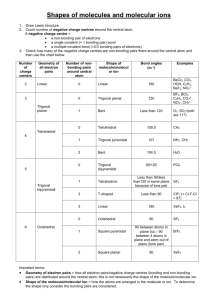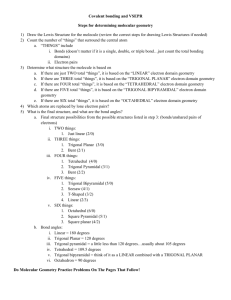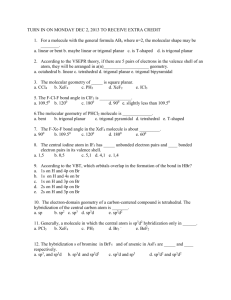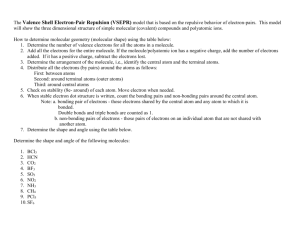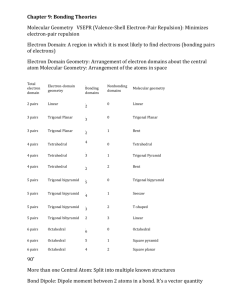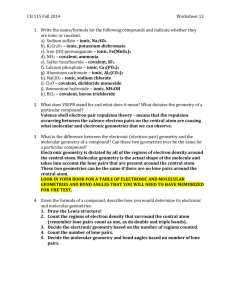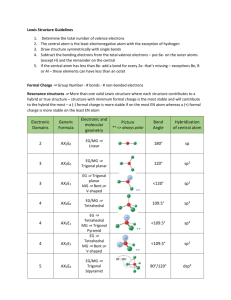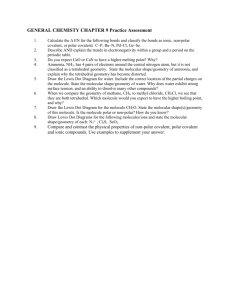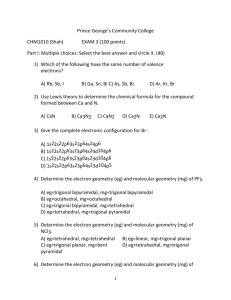Covalent Bonding & Molecular Compounds Multiple Choice Review
advertisement
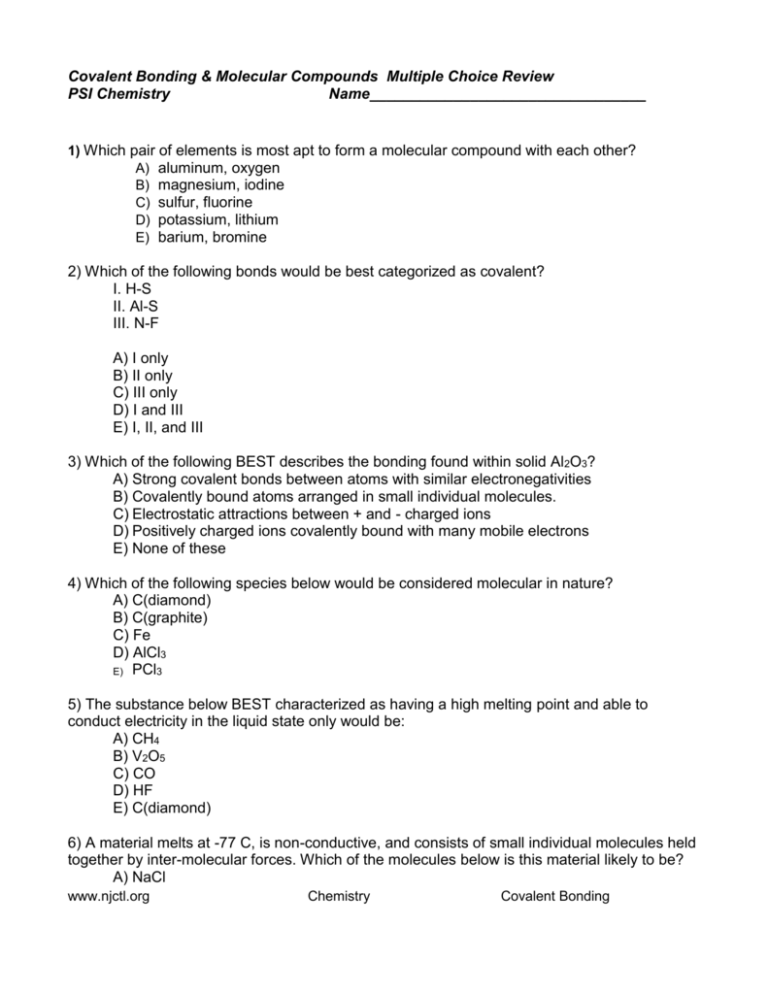
Covalent Bonding & Molecular Compounds Multiple Choice Review PSI Chemistry Name_________________________________ 1) Which pair of elements is most apt to form a molecular compound with each other? A) aluminum, oxygen B) magnesium, iodine C) sulfur, fluorine D) potassium, lithium E) barium, bromine 2) Which of the following bonds would be best categorized as covalent? I. H-S II. Al-S III. N-F A) I only B) II only C) III only D) I and III E) I, II, and III 3) Which of the following BEST describes the bonding found within solid Al2O3? A) Strong covalent bonds between atoms with similar electronegativities B) Covalently bound atoms arranged in small individual molecules. C) Electrostatic attractions between + and - charged ions D) Positively charged ions covalently bound with many mobile electrons E) None of these 4) Which of the following species below would be considered molecular in nature? A) C(diamond) B) C(graphite) C) Fe D) AlCl3 E) PCl3 5) The substance below BEST characterized as having a high melting point and able to conduct electricity in the liquid state only would be: A) CH4 B) V2O5 C) CO D) HF E) C(diamond) 6) A material melts at -77 C, is non-conductive, and consists of small individual molecules held together by inter-molecular forces. Which of the molecules below is this material likely to be? A) NaCl www.njctl.org Chemistry Covalent Bonding B) NH3 C) C(diamond) D) MgO E) Cu 7) Which of the following BEST explains the relatively low melting point of covalent molecular substances? A) Covalent molecular materials rely on weak electrostatic forces holding the ions together. B) The “sea” of electrons between the atoms creates relatively weak bonding C) The intermolecular forces between the molecules are weak compared to ionic or covalent bonds. D) The metals involved create uneven bonding with the non-metals E) The similar electronegativity of the atoms cause repulsions between the molecules 8) Which of the following would be characterized as a molecular compound? I. CO II. Zn(OH)2 III. Fe A) I only B) II only C) III only D) I and II E) I, II, and III 9) Which of the following would contain both covalent and Ionic bonding? A) CaO B) NH3 C) C(diamond) D) Ca(NO3)2 E) CO2 10) Rank the following bonds from most to least covalent in nature: (C-H, C-O, C-C, Al-O) A) C-H , C-O, Al-O, C-C B) C-O, C-H, C-C, Al-O C) C-C, C-H, Al-O, C-O D) Al-O, C-O, C-H, C-C E) C-C, C-H, C-O, Al-O 11) The correct name for SO is __________. A) sulfur oxide B) sulfur monoxide C) sulfoxide D) sulfate E) sulfite www.njctl.org Chemistry Covalent Bonding 12) The correct name for CCl4 is __________. A) carbon chloride B) carbon tetrachlorate C) carbon perchlorate D) carbon tetrachloride E) carbon chlorate 13) The correct name for N2O5 is __________. A) nitrous oxide B) nitrogen pentoxide C) dinitrogen pentoxide D) nitric oxide E) nitrogen oxide 14) The name of PCl3 is __________. A) potassium chloride B) phosphorus trichloride C) phosphorous(III) chloride D) monophosphorous trichloride E) trichloro potassium 15) The name of the binary compound N2O4 is __________. A) nitrogen oxide B) nitrous oxide C) nitrogen(IV) oxide D) dinitrogen tetroxide E) oxygen nitride 16) Which of the following would be nitrogen(I)oxide? A) NO B) NO2 C) N2O D) N2O3 E) N3O2 17) Which of the following is named INCORRECTLY? I. II. III. CO - carbon(II)oxide OF2 - diflourine oxide H3P - trihydrogen phosphide A) I only B) II only C) III only D) I and II E) I, II, and III 18) The correct name for H2O is __________. A) hydrogen oxide www.njctl.org Chemistry Covalent Bonding B) hydrogen(II) oxide C) dihydrogen oxide D) dihydrogen monoxide E) hydrogen dioxide 19) The correct name for XeF4 is __________. A) monoxenon pentafluoride B) xenon pentafluoride C) xenon tetrafluoride D) monoxenon tetrafluoride E) xenon fluorate 20) The correct name for P2O5 is __________. A) phosphorus oxide B) phosphorus pentoxide C) diphosphorus oxide D) phosphate E) diphosphorus pentoxide 21) The name of BCl3 is __________. A) boron chloride B) boron trichloride C) monoboron chloride D) trichloro boron E) monoboron trichloride 22) The name of the binary compound CS2 is __________. A) carbon sulfide B) monocarbon disulfide C) carbon disulfide D) carbon sulfate E) carbon disulfate Lewis Dot Structures 23) The type of compound that is most likely to contain a covalent bond is __________. A) one that is composed of a metal and a nonmetal B) a solid metal C) one that is composed of only nonmetals D) held together by the electrostatic forces between oppositely charged ions E) There is no general rule to predict covalency in bonds. 24) There are __________ paired and __________ unpaired electrons in the Lewis symbol for a Nitrogen atom. A) 4, 2 B) 2, 4 C) 2, 3 D) 4, 3 www.njctl.org Chemistry Covalent Bonding E) 0, 3 25) In the Lewis symbol for a sulfur atom, there are __________ paired and __________ unpaired electrons. A) 2, 2 B) 4, 2 C) 2, 4 D) 0, 6 E) 5, 1 26) In the Lewis symbol for an Iodine atom, there are __________ paired and __________ unpaired electrons. A) 4, 2 B) 4,1 C) 2, 5 D) 6, 1 E) 0, 5 27) There are __________ unpaired electrons in the Lewis symbol for an oxygen atom. A) 0 B) 1 C) 2 D) 4 E) 3 28) The only noble gas without eight valence electrons is __________. A) Ar B) Ne C) He D) Kr E) All noble gases have eight valence electrons. 29) Which of the following would have all of it’s valance electrons paired in it’s lewis structure representation? A) Al B) P C) S D) F E) Xe 30) How many single covalent bonds must a silicon atom form to have a complete octet in its valence shell? A) 3 B) 4 C) 1 D) 2 www.njctl.org Chemistry Covalent Bonding E) 0 31) How many hydrogen atoms must bond to silicon to give it an octet of valence electrons? A) 1 B) 2 C) 3 D) 4 E) 5 32) Which of the following atoms is without lone electrons to be shared? A) Al B) Be C) B D) He E) H 33) A double bond (1 sigma and 1 pi bond) consists of __________ pairs of electrons shared between two atoms. A) 1 B) 2 C) 3 D) 4 E) 6 34) A __________ covalent bond between the same two atoms is the longest. A) single B) double C) triple D) they are all the same length. E) strong 35) As the number of covalent bonds between two atoms increases, the distance between the atoms __________ and the strength of the bond between them __________. A) increases, increases B) decreases, decreases C) increases, decreases D) decreases, increases E) is unpredictable 36) What is the maximum number of double (pi) bonds that a hydrogen atom can form? A) 0 B) 1 C) 2 D) 3 E) 4 37) What is the maximum number of double (pi) bonds that a carbon atom can form? www.njctl.org Chemistry Covalent Bonding A) 4 B) 1 C) 0 D) 2 E) 3 38) In which of the molecules below is the carbon-carbon distance the shortest? A) H2C = CH2 B) H -- C ≡ C -- H C) H3C – CH3 D) H2C = C = CH2 E) H3C - CH2 - CH3 39) Of the bonds C – N, C = N, C ≡ N the C – N bond is __________. A) strongest/shortest B) strongest/longest C) weakest/shortest D) weakest/longest E) intermediate in both strength and length 40) Of the possible bonds between carbon atoms (single, double, and triple), __________. A) a triple (sigma +2pi) bond is longer than a single bond B) a double (sigma + pi)bond is stronger than a triple bond C) a single (sigma) bond is stronger than a triple bond D) a double (sigma + pi) bond is longer than a triple bond E) a single (sigma) bond is stronger than a double bond 41) The ion ICl4- has __________ valence electrons. A) 34 B) 35 C) 36 D) 28 E) 8 42) The ion NO- has __________ valence electrons. A) 15 B) 14 C) 16 D) 10 E) 12 43) The Lewis structure of AsH3 shows __________ nonbonding electron pair(s) on As. A) 0 B) 1 C) 2 D) 3 E) This cannot be determined from the data given. www.njctl.org Chemistry Covalent Bonding 44) The Lewis structure of PF3 shows that the central phosphorus atom has __________ nonbonding and __________ bonding electron pairs. A) 2, 2 B) 1, 3 C) 3, 1 D) 1, 2 E) 3, 3 45) The Lewis structure of HCN (H – C≡N) shows that __________ has __________ nonbonding electron pairs. A) C, 1 B) N, 1 C) H, 1 D) N, 2 E) C, 2 46) Of the following, __________ cannot accommodate more than an octet of electrons. A) P B) As C) O D) S E) I 47) A valid Lewis structure of __________ cannot be drawn without violating the octet rule. A) NH3 B) IF3 C) PF3 D) SbCl3 E) NO3148) A valid Lewis structure of __________ cannot be drawn without violating the octet rule. A) PO43B) PF3 C) CCl4 D) SeF4 E) NF3 49) The central atom in __________ does not violate the octet rule. A) SF4 B) KrF2 C) CF4 D) XeF4 E) ICl450) The central atom in __________ violates the octet rule. www.njctl.org Chemistry Covalent Bonding A) NH3 B) SeF2 C) BF3 D) AsF3 E) CH4 51) A valid Lewis structure of __________ cannot be drawn without violating the octet rule. A) ClF3 B) PCl3 C) SO3 D) CCl4 E) CO2 52) A valid Lewis structure of __________ cannot be drawn without violating the octet rule. A) NI3 B) SO2 C) ICl5 D) SiF4 E) CO2 53) A valid Lewis structure of __________ cannot be drawn without violating the octet rule. A) NF3 B) BeH2 C) SO2 D) CF4 E) SO3254) The central iodine atom in the ICl4- ion has __________ non-bonded electron pairs and __________ bonded electron pairs in its valence shell. A) 2, 2 B) 3, 4 C) 1, 3 D) 3, 2 E) 2, 4 55) The central iodine atom in IF5 has __________ non-bonded electron pairs and __________ bonded electron pairs in its valence shell. A) 1, 5 B) 0, 5 C) 5, 1 D) 4, 1 E) 1, 4 56) The central Xe atom in the XeF4 molecule has __________ non-bonded electron pairs and __________ bonded electron pairs in its valence shell. A) 1, 4 www.njctl.org Chemistry Covalent Bonding B) 2, 4 C) 4, 0 D) 4, 1 E) 4, 2 57) Which of the following correctly represents the lewis structure for PH3? A) B) C) D) 58) How many double (pi) bonds would be present in a CS 2 molecule? A) 0 B) 1 C) 2 D) 3 E) 4 59) Which of the following would be the correct lewis structure for methyl amine (CH3NH2)? A) B) C) D) Resonance 60) Resonance structures differ by __________. A) number and placement of electrons B) number of electrons only www.njctl.org Chemistry Covalent Bonding C) placement of atoms only D) number of atoms only E) placement of electrons only 61) How many equivalent resonance forms can be drawn for CO 32-- (carbon is the central atom)? A) 1 B) 2 C) 3 D) 4 E) 0 62) How many equivalent resonance forms can be drawn for SO 2 without expanding octet on the sulfur atom (sulfur is the central atom)? A) 0 B) 2 C) 3 D) 4 E) 1 63) How many equivalent resonance structures can be drawn for the molecule of SO 3 without having to violate the octet rule on the sulfur atom? A) 5 B) 2 C) 1 D) 4 E) 3 64) How many different types of resonance structures can be drawn for the ion SO32- where all atoms satisfy the octet rule? A) 1 B) 2 C) 3 D) 4 E) 5 65) In the nitrite ion NO2-, __________. A) both bonds are single bonds B) both bonds are double bonds C) one bond is a double bond and the other is a single bond D) both bonds are the same E) there are 20 valence electrons www.njctl.org Chemistry Covalent Bonding 66) The Lewis structure of the CO32- ion is __________. A B C D E 67) To convert from one resonance structure to another, __________. A) only atoms can be moved B) electrons and atoms can both be moved C) only electrons can be moved D) neither electrons nor atoms can be moved E) electrons must be added 68) For resonance forms of a molecule or ion, __________. A) one always corresponds to the observed structure B) all the resonance structures are observed in various proportions C) the observed structure is an average of the resonance forms D) the same atoms need not be bonded to each other in all resonance forms E) there cannot be more than two resonance structures for a given species VSEPR Numbers, Geometry, Hybridization, and Bond Angles 69) The basis of the VSEPR model of molecular bonding is __________. A) regions of electron density on an atom will organize themselves so as to maximize s-character B) regions of electron density in the valence shell of an atom will arrange themselves so as to maximize overlap C) atomic orbitals of the bonding atoms must overlap for a bond to form D) electron domains in the valence shell of an atom will arrange themselves so as to minimize repulsions E) hybrid orbitals will form as necessary to, as closely as possible, achieve spherical symmetry 70) According to VSEPR theory, if there are three electron domains in the valence shell of an atom, they will be arranged in a(n) __________ geometry. www.njctl.org Chemistry Covalent Bonding A) octahedral B) linear C) tetrahedral D) trigonal planar E) trigonal bipyramidal 71) An electron domain could consist of __________. I. a nonbonding pair of electrons II. a single sigma bond III. the pi bond component of a double or triple bond A) I only B) II only C) III only D) I, II, and III E) II and III only 72) According to VSEPR theory, if there are five electron domains in the valence shell of an atom, they will be arranged in a(n) __________ geometry. A) octahedral B) linear C) tetrahedral D) trigonal planar E) trigonal bipyramidal 73) According to VSEPR theory, if there are four electron domains in the valence shell of an atom, they will be arranged in a(n) __________ geometry. A) octahedral B) linear C) tetrahedral D) trigonal planar E) trigonal bipyramidal 74) In the valence shell of an atom there are six electron domains. They will be arranged in a (an) __________ geometry. A) hexagonal B) tetrahedral C) octahedral D) trigonal bipyramidal E) see-saw 75. Using the VSEPR model, the electron-domain geometry of the central atom in BF3 is _________ while the molecular geometry would be described as ______________. A) linear, bent www.njctl.org Chemistry Covalent Bonding B) trigonal planar, bent C) trigonal planar, trigonal planar D) trigonal bipyramidal, bent E) octahedral , square pyramidal 76. The electron-domain geometry of the central atom in OF2 is _________ while the molecular geometry would be described as_________________. A) linear, bent B) trigonal planar, bent C) tetrahedral, bent D) trigonal bipyramidal, linear E) octahedral, square pyramidal 77) The electron-domain geometry of the central atom in BrF3 is _______, while the molecular geometry would be described as____________. A) linear, linear B) trigonal planar, trigonal planar C) tetrahedral, triangular pyramidal D) trigonal bipyramidal, T shaped E) octahedral , octahedral 78) Using the VSEPR model, the electron-domain geometry of the central atom in BrF4- is _______ while the molecular geometry would be described as_______________. A) linear, bent B) trigonal planar, bent C) tetrahedral, bent D) trigonal bipyramidal, square planar E) octahedral , square planar 79) Which of the following would have an electron-domain geometry that is tetrahedral in nature? I. CH4 II. PH3 III. XeF4 A) I only B) II only C) III only D) I and II only E) I and III only 80) The electron-domain geometry and the molecular geometry of a molecule of the general formula ABn are __________. A) never the same B) always the same C) sometimes the same D) not related www.njctl.org Chemistry Covalent Bonding E) mirror images of one another 81) The electron-domain geometry and the molecular geometry of a molecule of the general formula ABn will always be the same if __________. A) there are no lone pairs on the central atom B) there is more than one central atom C) n is greater than four D) n is less than four E) the octet rule is obeyed 82) For a molecule with the formula AB2 the molecular shape is __________. A) linear or bent B) linear or trigonal planar C) linear or T-shaped D) T-shaped E) trigonal planar 83) PCl5 has __________ electron domains and a __________ molecular arrangement. A) 6, trigonal bipyramidal B) 6, tetrahedral C) 5, square pyramidal D) 5, trigonal bipyramidal E) 6, seesaw 84) The electron-domain geometry and molecular geometry of iodine trichloride are __________ and __________, respectively. A) trigonal bipyramidal, trigonal planar B) tetrahedral, trigonal pyramidal C) trigonal bipyramidal, T-shaped D) octahedral, trigonal planar E) T-shaped, trigonal planar 85) Using the VSEPR model, the molecular geometry of the central atom in XeF 2 is __________. A) linear B) trigonal planar C) tetrahedral D) bent E) trigonal pyramidal 86) Using the VSEPR model, the molecular geometry of the central atom in BCl 3 is __________. A) linear B) trigonal planar C) tetrahedral D) bent www.njctl.org Chemistry Covalent Bonding E) trigonal pyramidal 87) Using the VSEPR model, the molecular geometry of the central atom in CF 4 is __________. A) linear B) trigonal planar C) tetrahedral D) bent E) trigonal pyramidal 88) Using the VSEPR model, the molecular geometry of the central atom in SO2 is __________. A) linear B) trigonal planar C) tetrahedral D) bent E) trigonal pyramidal 89) Using the VSEPR model, the molecular geometry of the central atom in NCl 3 is __________. A) linear B) trigonal planar C) tetrahedral D) bent E) trigonal pyramidal 90) Using the VSEPR model, the molecular geometry of the central atom in PF 5 is __________. A) tetrahedral B) square planar C) trigonal bipyramidal D) seesaw E) square pyramidal 91) The molecular geometry of __________ is square planar. A) CCl4 B) XeF4 C) PH3 D) XeF2 E) ICl3 92) The molecular geometry of the CS2 molecule is __________. A) linear B) bent C) tetrahedral D) trigonal planar www.njctl.org Chemistry Covalent Bonding E) T-shaped 93) The molecular geometry of the SiH2Cl2 molecule is __________. A) trigonal planar B) tetrahedral C) trigonal pyramidal D) octahedral E) T-shaped 94) The molecular geometry of the PHCl2 molecule is __________. A) bent B) trigonal planar C) trigonal pyramidal D) tetrahedral E) T-shaped 95) The molecular geometry of the CHl3 molecule is __________. A) bent B) trigonal planar C) trigonal pyramidal D) tetrahedral E) T-shaped 96) The molecular geometry of the SF2 molecule is __________. A) linear B) bent C) trigonal planar D) tetrahedral E) octahedral 97) The molecular geometry of the H3O+ ion is __________. A) linear B) tetrahedral C) bent D) trigonal pyramidal E) octahedral 98) ClF3 has "T-shaped" geometry. There are __________ non-bonding domains in this molecule. A) 0 B) 1 C) 2 D) 3 E) 4 99) The electron domain and molecular geometry of BrO2- is _________. A) tetrahedral, trigonal planar www.njctl.org Chemistry Covalent Bonding B) trigonal planar, trigonal planar C) trigonal pyramidal, linear D) tetrahedral, bent E) trigonal pyramidal, seesaw 100) The molecular geometry of the BrO3- ion is __________. A) trigonal pyramidal B) trigonal planar C) bent D) tetrahedral E) T-shaped Questions 101-104 refer to the molecule below: 101) The molecular geometry of the left-most carbon atom in the molecule below is _____ A) trigonal planar B) trigonal bipyramidal C) tetrahedral D) octahedral E) T-shaped 102) The hybridization of the left-most and right most carbon atoms would be_____and _____respectively. A) sp, sp2 B) sp2, sp C) sp3, sp D) sp3, sp2 E) sp2, sp3 103) The H-C-H bond angle would most closely approximate _____ A) 180 degrees B) 120 degrees C) 117 degrees D) 109.5 degrees E) 107 degrees 104) The molecular geometry of the right-most carbon in the molecule below is __________. www.njctl.org Chemistry Covalent Bonding A) trigonal planar B) trigonal bipyramidal C) tetrahedral D) octahedral E) T-shaped 105) What is the molecular geometry of a molecule that has three bonding and two nonbonding domains? A) T-shaped B) Tetrahedral C) See-saw D) Square pyramidal E) Trigonal bipyramidal Consider the following species when answering the following questions: (i) PCl3 (ii) CCl4 (iii) TeCl4 (iv) XeF4 (v) SF6 106) For which of the molecules is the molecular geometry (shape) the same as the VSEPR electron domain arrangement (electron domain geometry)? A) (i) and (ii) B) (i) and (iii) C) (ii) and (v) D) (iv) and (v) E) (v) only 107) Which of the molecules has a see-saw shape? A) (i) B) (ii) C) (iii) D) (iv) E) (v) Choose from the following for questions #106-109 A) CH3Cl B) H2O C) N2 D) H2CCH2 E) H2NNH2 108) Contains the shortest bond length 109) Contains sp2 hybridized atom 110) Demonstrates a bent molecular geometry www.njctl.org Chemistry Covalent Bonding 111) Contains bond angles of 109.5 degrees Polarity 112) The ability of an atom in a molecule to attract electrons is best quantified by the __________. A) paramagnetism B) diamagnetism C) electronegativity D) electron change-to-mass ratio E) first ionization potential 113) Electronegativity __________ from left to right within a period and __________ from top to bottom within a group. A) decreases, increases B) increases, increases C) increases, decreases D) stays the same, increases E) increases, stays the same 114) Which covalent single bond is most polar? A) C — H B) N — H C) O— H D) O— C E) O— N 115) A nonpolar bond will form between two __________ atoms of __________ electronegativity. A) different, opposite B) identical, different C) different, different D) similar, different E) identical, equal 116) Of the molecules below, the bond in __________ is the most polar. A) HBr B) HI C) HCl D) HF E) H2 117) Of the bonds below, __________ is the least polar. A) Na, S B) P, S www.njctl.org Chemistry Covalent Bonding C) C, F D) Si, Cl E) Na, Cl 118) Which of the following has the bonds correctly arranged in order of increasing polarity? A) Be — F, Mg — F, N — F, O — F B) O— F, N — F, Be — F, Mg — F C) O— F, Be — F, Mg — F, N — F D) N — F, Be — F, Mg — F, O — F E) Mg — F, Be — F, N — F, O — F 119) Which two bonds are most similar in polarity? A) O— F and Cl — F B) B — F and Cl — F C) Al — Cl and I — Br D) I — Br and Si — Cl E) Cl — Cl and Be — Cl 120) Of the molecules below, only __________ is polar. A) SbF5 B) AsH3 C) I2 D) SF6 E) CH4 121) Of the molecules below, only __________ is nonpolar. A) CO2 B) H2O C) NH3 D) HCl E) TeCl2 122) Of the molecules below, only __________ is polar. A) CCl4 B) CH4 C) SeF4 D) SiCl4 E) CO2 123) Of the molecules below, only __________ is nonpolar. A) BF3 B) NF3 C) IF3 D) PBr3 E) BrCl3 124) The molecular geometry of the BeCl2 molecule is __________, and this molecule is www.njctl.org Chemistry Covalent Bonding __________. A) linear, nonpolar B) linear, polar C) bent, nonpolar D) bent, polar E) trigonal planar, polar 125) The molecular geometry of the PF3 molecule is __________, and this molecule is __________. A) trigonal planar, polar B) trigonal planar, nonpolar C) trigonal pyramidal, polar D) trigonal pyramidal, nonpolar E) tetrahedral, unipolar 126) Of the following molecules, only __________ is polar. A)BeCl2 B) BF3 C) CBr4 D) SiH2Cl2 E) Cl2 127) Of the following molecules, only __________ is polar. A)CCl4 B) BCl3 C) NCl3 D) BeCl2 E) Cl2 128) The molecular geometry of the CHF3 molecule is __________, and the molecule is __________. A) trigonal pyramidal, polar B)tetrahedral, nonpolar C) seesaw, nonpolar D) tetrahedral, polar E) seesaw, polar 129) The molecular geometry of the BCl3 molecule is __________, and this molecule is __________. A) trigonal pyramidal, polar B) trigonal pyramidal, nonpolar C) trigonal planar, polar D) trigonal planar, nonpolar E) trigonal bipyramidal, polar www.njctl.org Chemistry Covalent Bonding Answers 1. C 2. D 3. C 4. E 5. B 6. B 7. C 8. A 9. D 10. E 11. B 12. D 13. C 14. B 15. D 16. C 17. B 18. D 19. C 20. E 21. B 22. C 23. C 24. C 25. B 26. D 27. C 28. C 29. E 30. B 31. D 32. D 33. B 34. A 35. D 36. A 37. D 38. B 39. D 40. D 41. C 42. E 43. B www.njctl.org 44. B 45. B 46. C 47. B 48. D 49. C 50. C 51. A 52. C 53. B 54. E 55. A 56. B 57. D 58. C 59. A 60. E 61. C 62. B 63. E 64. A 65. D 66. A 67. C 68. C 69. D 70. D 71. E 72. E 73. C 74. C 75. C 76. C 77. D 78. E 79. D 80. C 81. A 82. A 83. D 84. C 85. A 86. B Chemistry 87. C 88. B 89. E 90. C 91. B 92. A 93. B 94. C 95. D 96. B 97. D 98. C 99. D 100. 101. 102. 103. 104. 105. 106. 107. 108. 109. 110. 111. 112. 113. 114. 115. 116. 117. 118. 119. 120. 121. 122. 123. 124. 125. 126. 127. 128. 129. Covalent Bonding A C D D A A C C C D B A C C C E D B B A B A C A A C D C D D
